Kristine Hughes's Blog, page 83
December 12, 2014
ON THE SHELF: AT HOME WITH JANE AUSTEN BY KIM WILSON
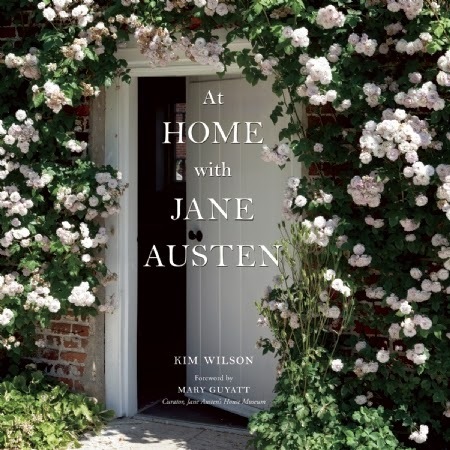 At Home With Jane Austen by Kim Wilson, 2014
At Home With Jane Austen by Kim Wilson, 2014Victoria here, enjoying the wonderful pictures and copy of this new book by my friend and colleague, Kim Wilson. Don't expect anything negative in this "review," because I love everything Kim does unreservedly. I am sure you will agree that all her books -- especially this beautiful edition from Abbeville Press -- deserve all the praise I can muster.
 Kim and Victoria giving a talk at the 2014 Montreal JASNA-AGM
Kim and Victoria giving a talk at the 2014 Montreal JASNA-AGMKim's lively account of Jane Austen's life is complemented with wonderful photographs and reproductions of period prints. Many of the pictures were commissioned from Gavin Kingcome, who portrays even the most familiar of views with an artist's eye. Other photos are taken by Kim herself.

From the very beginning, you will be charmed by the pictures and prose, perfect for enjoying cover to cover or for dipping into briefly during a comforting tea break.
In the foreword by the curator of of Jane Austen's House Museum, Chawton, Hampshire, Mary Guyatt writes, "This book cannot fail to encourage your own further exploration..." This is true for a dedicated devotee -- like myself -- or for a newcomer to Austen's life and work.
 Adlestrop Park, Gloucestershire
Adlestrop Park, GloucestershireOur journey with Jane Austen begins at her childhood home in Steventon, Hampshire, where she lived with her parents and sister Cassandra and her many brothers as well as some boarding students Mr. Austen taught in preparation for college. And we accompany her on the many visits she made in rural villages, sophisticated cities, and stately country mansions. Along the way, we learn about her many friends and relatives through her own words from her letters to her sister Cassandra.
 Bath, 1806
Bath, 1806On the many travels around England, we also encounter the settings for Austen's novels, in Bath, Lyme Regis, and London. And we discover clues about the imagined settings she used, such as the estates of Pemberley and Donwell Abbey.
 Chawton Cottage
Chawton CottageGardening, fashion, balls, literature, and the theatre - all pursuits Jane Austen enjoyed - are covered, as well as the personal activities in which she excelled, e.g. playing the piano and writing.
Indulge your Janeite friends, others who need to be initiated into the delights of Austen, and above all yourself -- with a gift of this gorgeous volume by Kim Wilson from Abbeville Press: At Home with Jane Austen.
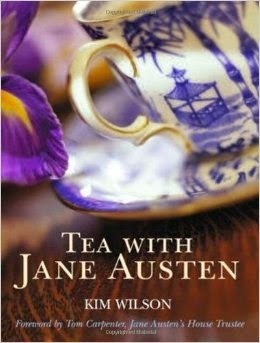
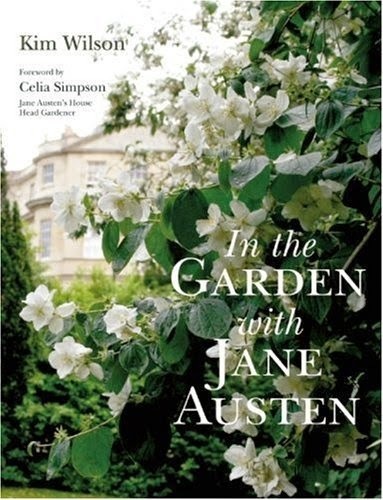
Kim Wilson's previous titles, still available, are Tea with Jane Austen and In the Garden with Jane Austen.
Published on December 12, 2014 00:30
December 9, 2014
VIDEO WEDNESDAY: PADDINGTON BEAR IS COMING TO TOWN!

PADDINGTON - THE MOVIEWATCH THE TRAILER HERE
You can watch another trailer here
Paddington: From Page to Screen - the Featurette
Paddington Meets the Brown Family - film clip
(I can't wait for this movie open)
Published on December 09, 2014 23:30
December 7, 2014
LOOSE IN LONDON: KENWOOD HOUSE - PART ONE

It’s a good thing I have a travel buddy like Victoria, who is not only tolerant of my often eccentric tourist plans, but who, more often than not, joins in wholeheartedly. Take Kenwood House, for instance. I’d been there with my daughter, Brooke, before they’d renovated the interiors. This time out, Victoriawanted to take it all in and suggested that we put it on the itinerary before the Wellington Tour began.
“Fine by me,” I told her.
“You don’t mind going back? In any case, it will all be different, now that the renovations are finished.”
“Oh, I don’t care all that much about the interiors,” I said. “I want to see Londonfrom the Heath. And highwaymen.” Now, this is what’s so great about Vicky – she didn’t question my reference to highwaymen in any way. Instead, she instinctively knew what I was on about.
“That’s Hounslow.”
“Hampstead, too.”
“Really?”
“Hhhmm. Why not? Footpads and highwaymen laid by Hounslow Heath cause the Great Western Roadand the Bath Roadbrought travelers and coaches through. They had to come through Hampstead for the Great North Road, so why not highwaymen? Oh, and I want to see the dairy.”
“At Hampstead?”
“At Kenwood. Supposedly there’s a period dairy on the grounds. And some sort of bath.”
“A bath or baths?”
“I don’t know how many they have.”
“Do you mean baths or do you mean baths, like in Bath?”
“Bath. But Bath itself has several baths,” I reflected.
So, on a warm Saturday morning in September, Victoria and I found ourselves at Kenwood House, seated on a bench overlooking Hampstead Heath and the City of London. It's fabulous when one's dreams become a reality, no? And here I was, sharing it all with Victoria.

Views from Hampstead Heath over the City

We sat side by side on the bench for a time, each of us silently contemplating the views before we made our way towards Kenwood House proper. Here's a map of the area.
 Helpful to the Wanderer
Helpful to the Wanderer
Just inside the gate is this gardener's cottage on the grounds of Kenwood House.

A short stroll brought us to one of our objectives - the baths.

We made our way down a flight of stairs to the entrance of the baths themselves.

The Cold Bath - not very inviting but we were glad that the renovations were underway.

Just outside the baths, we found these stairs and a doorway that beckoned . . . . .
 View from the Terrace
View from the TerraceClimbing the stairs, we arrived on the terrace at the rear of the house.

 The Orangery
The OrangeryAs you can see, the views were stunning and we decided to walk down to the dairy before touring the house.

On the way, we encountered several others strolling the grounds, including the cutie below, whose name, we learned, was Duke. Really. Not even kidding. Duke.
 Our Pal
Our Pal Who could resist this face?
Who could resist this face? Around to the front entrance
Around to the front entrance The classical portico, added by Robert Adam for William Murray, 1st Earl of Mansfield
The classical portico, added by Robert Adam for William Murray, 1st Earl of Mansfield
 walking the paths toward the Dairy
walking the paths toward the Dairy Magpie
Magpie Dairy
DairyWe finally arrived at the dairy, only to discover that it was closed. Apparently it's only open to the public one day each week and this wasn't that day.
"Too bad it's closed. I know you wanted to see it," Victoria said.
"And I thought there'd be cows. In my mind there were cows. And milkmaids. In period costume."
"In your mind there are always period costumes."
We strolled around the area for a bit, taking in the atmosphere and appreciating the bucolic surroundings.
 Dairy
Dairy
By this time, we were both a bit peckish, so we decided to walk back to the cafe for lunch before touring the house.
 Roses in the Brewhouse Restaurant garden
Roses in the Brewhouse Restaurant garden
 Brewhouse Restaurant
Brewhouse Restaurant
Victoria decided upon a salad accompanied by wine, whilst I opted for my first scone and pot of tea since landing on English soil.
"Hey, Vic," I said through a mouthful of clotted cream.
"Hhhmmm?"
"I have something to say to you and I want you to look me in the eye while I say it."
"Is it something bad?"
"Non. It's something good. You ready?"
Victoria nodded.
"Here we are. Together. In London. At Kenwood House. Like we planned. It's finally happening."
Victoria grinned at me. "I know. It's terrific. Alone together in England. Like minded travelers wallowing in British history."
"Our history bucket lists come to life. With only ourselves to cater to. We can overdose on 19th century Britain and Wellington to our hearts content."
I'm not certain, but I think it was at this point that Victoria and I clapped our hands together and laughed with childlike glee.
"But that's not the best part," I told her.
"It's not?"
"Non. This is the best part," I said, leaning in conspiratorially. "This is only our first stop, on our very first day. We still have over three weeks of all things Wellington ahead of us." I know we laughed like loons at this point.
Once we'd recovered ourselves, we decided to use the loo before wandering towards the house. I tell you this because it was in the loo that I struck up a conversation with a really nice lady named Frances. The three of us walked outside and continued the conversation, talking about where Frances had been in the U.S. and where we'd been in England. Then I handed her our Number One London business card, which prompted her to tell us that she loved historical research, herself being a direct descendant of architect James Wyatt. Which prompted even more discussion, as you may well imagine.

Finally, Victoria and I entered the house and were greeted by two volunteers, who welcomed us warmly and asked us if this was our first visit to Kenwood House. Victoria told the young man that she'd been to the house before and had also seen the traveling exhibit of its artwork when it showed in Milwaukee. Which led to more discussion and mention of our blog. I handed him our card.
"I know this site," he said. "It's great."
Victoria and I glanced at each other. Was he having us on?
"I have a blog about London, too. The Lost Valley of London . I travel round London and shoot videos of out of the way places and my adventures."
This jogged my memory. "Wait a minute," I said, "I know your site. You wear a pith helmet, right?" Really, what were the odds that Anthony and I should meet at Kenwood House? All of this led to more discussion and mutual admiration, which lasted another few minutes.
We did, finally, tour the house and for that part of our visit I hand you over to Victoria, who will be bringing you Part Two of our day at Kenwood House soon.
Published on December 07, 2014 23:30
DEATH OF MARSHAL NEY, DECEMBER 7, 1815
Victoria, here. I've been doing a bit of research on the Battle of Waterloo and the Duke of Wellington lately. I can't get enough of either topic!! Things are getting so exciting for the 200th anniversary of the battle next June -- with all the exhibitions and events -- most of which you will learn about here on this blog -- sooner or later.
Ordinarily I don't have a great deal of affection or sympathy for the French side. Napoleon -- well, he has plenty of apologists and groupies, so he doesn't need me.
But what about some of his generals? While he was in exile on St. Helena, Napoleon ranted and raved about the causes of his defeats, taking no responsibility for his own leadership but usually blaming others, especially his generals.
This is the 199th "anniversary" of the execution of Marshall Michel Ney, the Bravest of the Brave, by a firing squad in Paris on December 7, 1815.
 Execution of Marshall Ney
Execution of Marshall Ney
Ney was born in 1769 to a modest family and had a good education, becoming a minor clerk and mine inspector. But in 1787, he joined the army as a Hussar, and was rapidly promoted through the ranks, fighting in numerous battles. He became a commissioned officer in 1792 and was made a general five years later, leading various cavalry units.
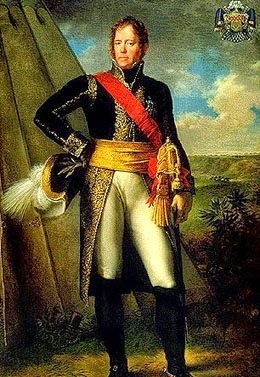
He continued his promotions, became a Marshal of the Empire, fighting in Austria and Spain, defeating the British several times in Portugal until he was forced to retreat from Wellington's fortifications at Torres Vedres.
Ney commanded the Third Corps in Napoleon's invasion of Russia in 1812. Despite being wounded i the neck, one of many he received in his lifetime, he continued to fight and led the rear-guard, known as the last Frenchman to leave Russia. Napoleon named his Prince de la Moskowa, though he was always known as Marshal Ney.
 Ney leading troops in Russia
Ney leading troops in Russia
After Russia, Ney led troops in many of Napoleon's battles but eventually became the leader of the general's revolt and told Napoleon at Fontainebleau in 1814 that French troops refused to march on Paris, and that the Emperor should abdicate.
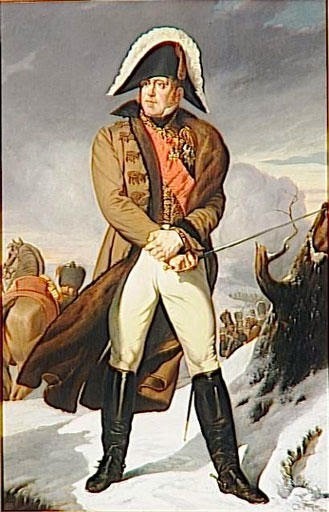 Ney leaves Russia
Ney leaves Russia
After Napoleon went to Elba, Ney became a leader of Louis XVIII's army. When Napoleon returned to France in 1815, Ney lead forces to stop him, but when he met Napoleon once more, he defected to the former Emperor's side with his 60,000 troops. This was the reason Ney was tried and executed after Napoleon was defeated once more -- at Waterloo.
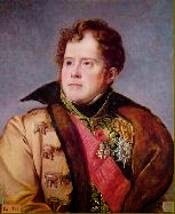
At Waterloo, Ney had four or five horses shot from under him. Many have criticized his tactics, but no one doubted his bravery in battle. Supposedly, as the Imperial Guard retreated, he dared someone to shoot him. "Come and see how a French Marshal dies," he supposedly shouted. But, amazingly, he was not seriously injured.
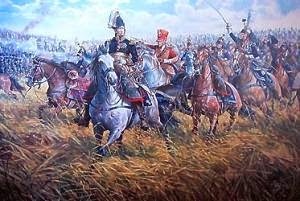 Ney leading the Curraissiers at Waterloo
Ney leading the Curraissiers at Waterloo
Ney was arrested and tried by the Chamber of Peers on December 4, 1815. He was age 46.
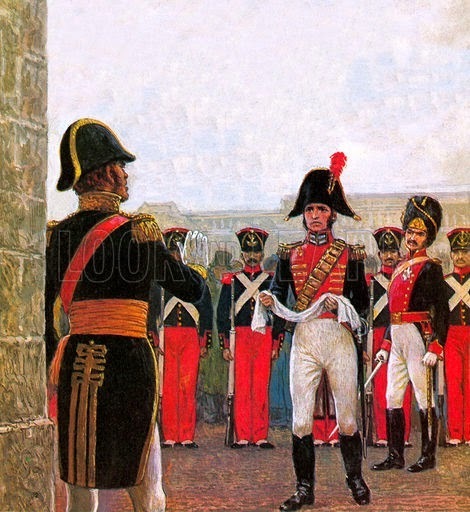 Ney refuses the blindfold.
Ney refuses the blindfold.
According to legend, he refused to wear a blindfold and gave the order to fire himself, saying,
 Ney's tomb, Père Lachaise Cemetery, Paris
Ney's tomb, Père Lachaise Cemetery, Paris
A statue of Ney was erected in Paris in 1853, standing on rue de l'Observatoire, across from the Closerie des Lilas Cafe, remembered as a favorite haunt of Ernest Hemingway.
 Ney Sculpture
Ney Sculpture
Inscriptiuon: A LA MÉMOIRE DU MARÉCHAL NEYDuc DelchingenPrince de la Moskowa7 Décembre 1853
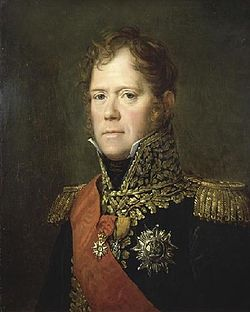 Marshal Michel Ney 1769-1815
Marshal Michel Ney 1769-1815
Ordinarily I don't have a great deal of affection or sympathy for the French side. Napoleon -- well, he has plenty of apologists and groupies, so he doesn't need me.
But what about some of his generals? While he was in exile on St. Helena, Napoleon ranted and raved about the causes of his defeats, taking no responsibility for his own leadership but usually blaming others, especially his generals.
This is the 199th "anniversary" of the execution of Marshall Michel Ney, the Bravest of the Brave, by a firing squad in Paris on December 7, 1815.
 Execution of Marshall Ney
Execution of Marshall NeyNey was born in 1769 to a modest family and had a good education, becoming a minor clerk and mine inspector. But in 1787, he joined the army as a Hussar, and was rapidly promoted through the ranks, fighting in numerous battles. He became a commissioned officer in 1792 and was made a general five years later, leading various cavalry units.

He continued his promotions, became a Marshal of the Empire, fighting in Austria and Spain, defeating the British several times in Portugal until he was forced to retreat from Wellington's fortifications at Torres Vedres.
Ney commanded the Third Corps in Napoleon's invasion of Russia in 1812. Despite being wounded i the neck, one of many he received in his lifetime, he continued to fight and led the rear-guard, known as the last Frenchman to leave Russia. Napoleon named his Prince de la Moskowa, though he was always known as Marshal Ney.
 Ney leading troops in Russia
Ney leading troops in RussiaAfter Russia, Ney led troops in many of Napoleon's battles but eventually became the leader of the general's revolt and told Napoleon at Fontainebleau in 1814 that French troops refused to march on Paris, and that the Emperor should abdicate.
 Ney leaves Russia
Ney leaves RussiaAfter Napoleon went to Elba, Ney became a leader of Louis XVIII's army. When Napoleon returned to France in 1815, Ney lead forces to stop him, but when he met Napoleon once more, he defected to the former Emperor's side with his 60,000 troops. This was the reason Ney was tried and executed after Napoleon was defeated once more -- at Waterloo.

At Waterloo, Ney had four or five horses shot from under him. Many have criticized his tactics, but no one doubted his bravery in battle. Supposedly, as the Imperial Guard retreated, he dared someone to shoot him. "Come and see how a French Marshal dies," he supposedly shouted. But, amazingly, he was not seriously injured.
 Ney leading the Curraissiers at Waterloo
Ney leading the Curraissiers at WaterlooNey was arrested and tried by the Chamber of Peers on December 4, 1815. He was age 46.
 Ney refuses the blindfold.
Ney refuses the blindfold.According to legend, he refused to wear a blindfold and gave the order to fire himself, saying,
"Soldiers, when I give the command to fire, fire straight at my heart. Wait for the order. It will be my last to you. I protest against my condemnation. I have fought a hundred battles for France, and not one against her ... Soldiers, fire!"
 Ney's tomb, Père Lachaise Cemetery, Paris
Ney's tomb, Père Lachaise Cemetery, ParisA statue of Ney was erected in Paris in 1853, standing on rue de l'Observatoire, across from the Closerie des Lilas Cafe, remembered as a favorite haunt of Ernest Hemingway.
 Ney Sculpture
Ney SculptureInscriptiuon: A LA MÉMOIRE DU MARÉCHAL NEYDuc DelchingenPrince de la Moskowa7 Décembre 1853
 Marshal Michel Ney 1769-1815
Marshal Michel Ney 1769-1815
Published on December 07, 2014 00:30
December 4, 2014
DO YOU KNOW ABOUT . . . . THE CORNISH RIVIERA EXPRESS?
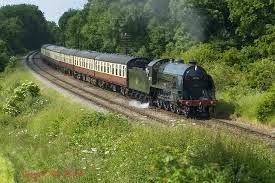
Whenever I think of train travel, I think of the Orient Express, or those night sleeper cars often seen in old black and white movies. The elegance of it all! The gently rocking guest rooms, the sofas that are converted into beds at night by white gloved attendants, cocktails in the lounge while listening to Gershwin tunes played on the baby grand by a tuxedo clad pianist and the elegant dining room, its tables laid with china, cut glass and gleaming silverware. All things of the past.
Until I found out about the Cornish Riviera Express, which travels from London to Cornwall, leaving Paddington Station almost daily at 10:30 p.m. The train arrives next morning with stops in Plymouth, Truro and Penzance. There's a wonderful site called The Man in Seat 61, from which I've swiped the photos below. Also on the site are all the details you'll need to plan a trip onboard of your own.

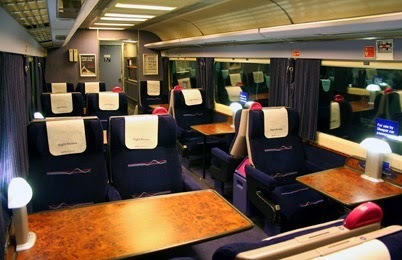
As the photos above illustrate, the Cornish Riviera Express is much less luxurious than the Orient Express, but the fact that one can still experience a night journey on a train is remarkable. I must fit this in to a future itinerary. The price is certainly right -
From £49 to £169 depending on single or double berth
You'll find the official Great Western site here with more information and photos.
You can watch a short video of the train as it steams it's way through Dawlish, hugging the magnificent shoreline here.
And you can learn more about the background history of the train from this posting on Wikipedia:
The Cornish Riviera Express is a British express passenger train that has run between London and Penzance in Cornwallsince 1904. Introduced by the Great Western Railway, the name Cornish Riviera Express has been applied to the late morning express train from London Paddington station to Penzance station continuously through nationalisation under British Rail and privatisation under First Great Western, only ceasing briefly during the two World Wars. The name is also applied to the late morning express train running in the opposite direction from Penzance to London. Through performance and publicity the Cornish Riviera Express has become one of the most famous named trains in the United Kingdom and is particularly renowned for the publicity employed by the GWR in the 1930s which elevated it to iconic status.Through trains from Paddington to Penzance began running on 1 March 1867 and included fast services such as the 10:15 a.m. Cornishman and 11:45 a.m. Flying Dutchman , but these still took nine hours or more for the journey.A new express service with limited stops was promoted by the Great Western Railway, commencing on 1 July 1904. It left London at 10:10 a.m. and was timed to reach Penzance at 5:10 p.m. It conveyed six carriages to Penzance, including a dining car, and one more carriage for Falmouth that was detached at Truro then added to a branch train to complete its journey. Other stops were made at Plymouth North Road (Devon), Gwinear Road (for the Helston branch), and St Erth (for the St Ives branch). The return train from Penzance started at 10:00 a.m. and called additionally at Devonport.A public competition was announced in the August 1904 edition of the Railway Magazine to choose the name, the prize being three guineas (£3.15) . Among the 1,286 entries were two suggestions, The Cornish Riviera Limited and The Riviera Express, which were combined as The Cornish Riviera Express, although railwaymen tended to call it The Limited.For the first two years, the new train ran only during the summer, but from the third year became a year-round feature of the timetable. With the opening of a 20¼ mile shorter route along the Langport and Castle Cary Railway in 1906, it was possible to start the train twenty minutes later from Paddington and still arrive in Penzance at the same time. New 68 foot (21 m) Concertina carriages were scheduled for the train at the same time. Additional slip coaches were added to be dropped from the train on the move at various stations to serve holiday destinations such as Weymouth, Minehead, Ilfracombe, and Newquay, and the train began to run non-stop to Newton Abbot where a pilot engine was added for the climb over the Dainton and Rattery banks, the southern outliers of Dartmoor. By the middle of World War I the train had grown to 14 coaches, even running in two portions on summer Saturdays, but the train was suspended in January 1917 as a wartime economy measure.Running of The Limited resumed in summer 1919 although a 60 mph blanket speed limit was still in force, and it wasn't until autumn 1921 that pre-war timings were reinstated. In 1923 new steel-panelled coaches and, more importantly the introduction of the Castle Class locomotives, billed as the "most powerful locomotive in Britain". This allowed the train to travel to Plymouth without the need to stop to attach a pilot locomotive, use of slip coaches keeping the load below the 310 ton limit for the Castle Class. However the pre-eminence of the Castle class did not last long as the Southern Railway Lord Nelson class of 1926 topped them for tractive effort, and so the King class was developed, particularly with the heavy West-country holiday trains in mind. Their introduction from 1927 allowed arrival in Plymouth to reach the 4 hour mark, although the increased weight of these locos prevented their use in Cornwall. The King class were also permitted an increased maximum load of 360 tons between Newton Abbot and Plymouth; above this a stop was required to attach a pilot locomotive.1935 saw new coaches in the shape of the 9 feet 7 inch (2.9 m) wide Centenary carriages , but there were few other significant changes until World War II. At the outbreak of war all trains to the West country were to travel via Bristol, and departure of the Cornish Riviera Limited was moved to 14:35, although this change only lasted until October when the departure time returned to 10:30 with Exeter as the first stop. By summer 1941 it seemed that everyone was taking their (brief) summer holidays in the West Country, and the Cornish Riviera Limited ran in five sections, to Penzance, Penzance, Paignton, Kingswear and Newton Abbot respectively. Ironically the Limited ran throughout the war, but was cancelled in the winter of 1946/47 due to a coal shortage, not being restored until the following summer although pre-war schedules were not regained until autumn 1955 by which time the railways had been nationalised and the 1955 Modernisation Plan had been published.The service was dieselised in the late 1950s. D1000 Western diesel-hydraulics introduced in 1964 could keep the four-hour schedule to Plymouth even with a 500 ton train and an additional stop at Taunton. Further cuts in time saw Plymouth being scheduled in 3 hours 35 minutes before the Westerns were withdrawn in 1977 to be replaced by Class 50Diesel-electrics hauling Mk2d/e/f air-conditioned coaches. These were, in turn, replaced in autumn 1981 by HSTs.After rail privatisation, the service is now operated by First Great Western, still using HSTs which are now undergoing refurbishment to see them past their quarter-century and within touching distance of the 31 years for which the King class were synonymous with the Cornish Riviera Limited.
Published on December 04, 2014 23:30
December 3, 2014
VIDEO WEDNESDAY: THE RESTORATION OF STOKE HALL
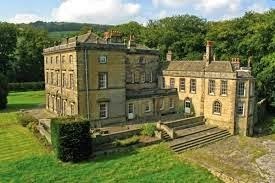
One of the UK shows I like to watch on YouTube is Restoration Home, in which homeowners restore historic houses whilst historians uncover the story of both the houses and the families who lived in them.
In this episode, the house under renovation is Stoke Hall, a thirty room Georgian mansion located eight miles from Chatsworth House in Derbyshire. The Grade II listed building is leaking and is being threatened by dry rot, but it's surviving architectural details and historical importance prompt new owners Steve and Natalie Drury to set about restoring the house to it's 18th century glory.
In this episode, architect Kieran Long explains Stoke Hall's construction and decorative details, whilst Dr. Kate Williams uncovers the story of some of those who lived at Stoke Hall - Robert Arkwright, whose grandfather made millions from his inventions during the Industrial Revolution, was living at Stoke Hall when he scandalized his family by eloping with actress Frances Kemble. His elder brother Richard was hot the heels of the couple, but arrived too late to stop the marriage. Luckily for us, Frances, the new lady of Stoke Hall, kept a scrapbook, in which she's saved pressed flowers from the 6th Duke of Devonshire. And, it seems that the Duke invited the Arkwright's to be guests at Chatsworth when Princess Victoria, aged 13, visited in 1832. That night, Mrs. Arkwright sang for the Duke's guests - and so did Victoria.
More history on those who have owned Stoke Hall can be found in the blurb from Wikipedia below.
You can watch the restoration of Stoke Hall here (1 hour)
A follow up episode, Stoke Hall: One Year On
can be found here
Stoke Hall is a Grade II* listed Georgian Palladian mansion near the village of Grindleford, Derbyshire, England. Listed in the Domesday Book, the first known occupant of Stoke was Gerbert de Stoke, in 1204. Stoke was held by the Greys of Codnor and sold in the 1460s to the Barlows of Barlow Hall.In the 17th-century it was owned by William Cavendish, 1st Duke of Newcastle. Early in the next century, it passed to the Rev John Simpson, who commissioned the current building following his acquisition of the estate upon his marriage to the granddaughter of Admiral Benbow. The house was designed by James Paine and built c. 1757 by William Booth. Both men also worked at nearby Chatsworth House. It was later described by Nicholas Pevsner as ‘quite stately'.In about 1850 Simpson's descendant Henry Bridgeman, 5th Earl of Bradford sold the estate to the Hunter family of Greystones, who lived there until at least the late 1930s.The Hall was later occupied by the industrialist Emile Viner, until 1950/1, and was then purchased by Hedley and Ida Abson, becoming a family home. After Hedley and Ida died, the Hall was sold in 1972, and subsequently used as a hotel and restaurant. It was sold at auction to Richard Jowitt in 1982. After an incomplete 25-year restoration, Jowitt died, and the house was offered for sale in 2008, with a guide price of £2.75 million, but not sold until 2009 for £2.5 million to a local couple, Steve and Natalie Drury, who have spent a further £1.5 million completing the restoration. Their restoration was shown by the BBC in 2011 and 2012.
Published on December 03, 2014 00:00
December 1, 2014
LOOSE IN LONDON: STREET SIGNS - PART ONE
Published on December 01, 2014 00:00
November 28, 2014
DO YOU KNOW ABOUT THE KING EDWARD VII ESTATES?
Kristine here - By now, most of you know about my hobby of web shopping for real estate in England. Recently, I discovered a new residential development in the South Downs National Park and had to share it with you.
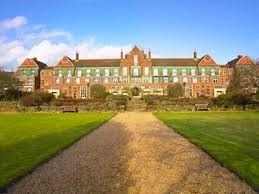
KING EDWARD VII ESTATE, MIDHURST
King Edward VII Estate sits within the South Downs National Park (an Area of Outstanding Natural Beauty) in West Sussex, 7 miles south of the small town of Haslemere. It comprises a unique mix of Grade II and II* Listed buildings which are being meticulously restored and converted into 162 exceptional apartments, duplexes and houses which will combine all the original character features of the existing buildings with stylish modern specifications. Further, a range of 247 new apartments and houses will be built in the surrounding area. Part of the restoration process will also see the gardens, originally planted by the acclaimed horticulturalist Gertrude Jekyll, meticulously restored for all residents to enjoy.
The Visitor Centre is open daily 10am to 5pm and the first show homes will be available to view from January 2015. Register your interest now for an early preview.
The contemporary interiors are created using a palette of pastel colours which blend perfectly with the historic features of the properties. Each home has also been cleverly designed to maximise space and natural light, with careful attention paid to every detail of the interior finishes.

The Gardens
The elegant gardens of the King Edward VII Hospital were designed by the highly acclaimed garden designer, Gertrude Jekyll. She worked closely with Percy Adams to allow the integration of the architecture and gardens that can still be seen today.
The gardens are an early 20th Century example of a therapeutic garden and are of considerable historic interest in their own right, which is recognised by their listing on the English Heritage Register of Parks and Gardens. They have further significance in the combination of the Percy Adams and Charles Holden designed Sanatorium and the Jekyll designed landscape, their unity encapsulating many of the aspirations of the Edwardian era.
This was one of Jekyll’s most ambitious and complex projects, she produced 40 planting drawings for both the formal gardens to the south and the main drive way to the north where the planting merged into the natural vegetation. Although since the setting out of the original design over 100 years ago, some of the Jekyll gardens have succumbed to the need for new buildings, extensions and car parking, the gardens to the south of the hospital remain remarkably intact.
The gardens are a nationally important heritage asset, and a unique example of Jekyll’s belief in the benevolence of plants and their benefits to patients, in their restored form they will continue to deliver these benefits for both residents and visitors. Detailed planting plans, based on the original drawings have been drawn up to restore the original intention of the planting which in many areas has become impoverished, and it is intended to restore some areas of the garden which have been ‘lost’ for decades below car parks and hospital out buildings.
This was one of Jekyll’s most ambitious and complex projects, she produced 40 planting drawings for both the formal gardens to the south and the main drive way to the north where the planting merged into the natural vegetation. Although since the setting out of the original design over 100 years ago, some of the Jekyll gardens have succumbed to the need for new buildings, extensions and car parking, the gardens to the south of the hospital remain remarkably intact.
The gardens are a nationally important heritage asset, and a unique example of Jekyll’s belief in the benevolence of plants and their benefits to patients, in their restored form they will continue to deliver these benefits for both residents and visitors. Detailed planting plans, based on the original drawings have been drawn up to restore the original intention of the planting which in many areas has become impoverished, and it is intended to restore some areas of the garden which have been ‘lost’ for decades below car parks and hospital out buildings.
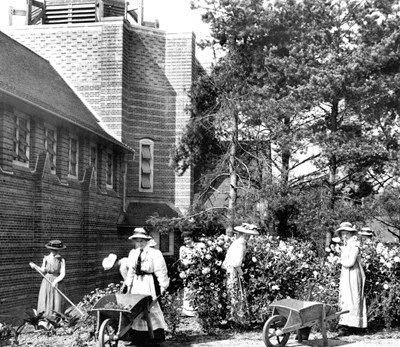
The History
“The King’s Sanatorium” was founded in 1901 to care for those suffering from tuberculosis and was officially opened on the 13th June 1906 by His Majesty King Edward VII, who gave assent for the institution to be called the King Edward VII Sanatorium. At the time when the sanatorium was designed it was heralded as a significant advancement in the treatment of the sick, where the importance of rest, relaxation, fresh air and light were incorporated into the buildings and surroundings as these were seen as equally important to the treatment of patients as the medical intervention. After the eradication of tuberculosis the sanatorium was transformed into a modern hospital admitting NHS and private patients with all types of illnesses. It also specialised in cancer care, cardiology and facial reconstruction.
The hospital was designed by Charles Holden and Percy Adams. Charles Holden went on to become a leading English architect who is best known for his designs in the 1920s and 1930s of London Underground stations. He was also a highly regarded figure in the architectural community, with Charles Rennie Macintosh being one of the key figures he is known to have influenced. The hospital was highly acclaimed in the architectural press when completed. It was said to be ‘one of the three finest of the time’ in the Royal Commission survey of English Hospitals: 1660 to 1948, and was highly praised by Pevsner. Charles Holden could have been Sir Charles Holden, but he turned down the offer.
Until the 1950’s the building faired well, with the necessary extensions being designed in a sensitive manner. However, from the 1960’s onwards such sensitivity was put aside, with the practicalities of a hospital being the overriding influence. These unfortunate additions paid little regard to the historic architecture and landscape. Despite this much of the historic fabric and quality remains, and the upgrading to Grade II* listing in 2004 for the main building and chapel underline the importance of this collection of historic buildings.
Intrigued? You will find more details here.
Published on November 28, 2014 00:00
November 26, 2014
VIDEO WEDNESDAY

Hugh Laurie explains why London is the perfect film set.
Stormchaser - How they filmed the horse chase scene at Wellington Arch, with the Horse Guards and closing down Piccadilly for a four hour shoot.
Gus Pomroy takes us on a tour of London sites associated with Sherlock Holmes.
Christopher Winn shows us six of the best London Bond film locations.
A BBC film (30 mins) on the changing face of the London suburbs on film.
Helen and Olly answer the question Where Is Britain's Hollywood?
And finally, click here to see video of some of the most ludicrous depicitions of London on film.
Published on November 26, 2014 00:00
November 21, 2014
CONSTABLE AT THE VICTORIA AND ALBERT MUSEUM, LONDON
Victoria here. Kristine and I were fortunate enough to attend preview of the Constable exhibition now on view at the Victoria and Albert museum in London.
 According to the Exhibition curator, "Constable: The Making of Master reveals the hidden stories of how John Constable created some of his most loved and well-known paintings. On display are such famous works as The Haywain together with the oil sketches he painted outdoors direct from nature." The exhibition continues in London until January 11, 2015. If you are near London, don't miss it.
According to the Exhibition curator, "Constable: The Making of Master reveals the hidden stories of how John Constable created some of his most loved and well-known paintings. On display are such famous works as The Haywain together with the oil sketches he painted outdoors direct from nature." The exhibition continues in London until January 11, 2015. If you are near London, don't miss it.
 Constable is one of England's best-loved painters. Born in 1776 in Suffolk, he studied hard to become a painter of note, though he was elected to the Royal Academy only at age 52. The exhibition looks at the paintings he studied, and shows many of his sketches for later works that continue to capture the public imagination two hundred years later.
Constable is one of England's best-loved painters. Born in 1776 in Suffolk, he studied hard to become a painter of note, though he was elected to the Royal Academy only at age 52. The exhibition looks at the paintings he studied, and shows many of his sketches for later works that continue to capture the public imagination two hundred years later.
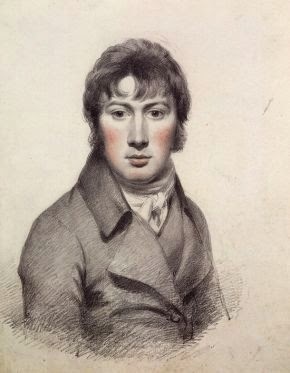 John Constable 1776-1837Self Portrait, from the National Portrait Gallery, London
John Constable 1776-1837Self Portrait, from the National Portrait Gallery, London
 Thomas Gainsborough, Landscape with a Pool, c. 1747Fitzwilliam Museum, Cambridge University Among the many influences on Constable was his fellow native of East Anglia, Thomas Gainsborough (1727-1788). Constable is said to have preferred the more natural style of Gainsborough's early landscapes to his celebrated portraiture. Below, Landscape with a Pool in the Constable exhibition.
Thomas Gainsborough, Landscape with a Pool, c. 1747Fitzwilliam Museum, Cambridge University Among the many influences on Constable was his fellow native of East Anglia, Thomas Gainsborough (1727-1788). Constable is said to have preferred the more natural style of Gainsborough's early landscapes to his celebrated portraiture. Below, Landscape with a Pool in the Constable exhibition.
 Claude Lorrain (1604/5-82) -- below -- was another strong influence on Constable in developing his landscape style.
Claude Lorrain (1604/5-82) -- below -- was another strong influence on Constable in developing his landscape style.
 Landscape with Hagar and the Angel, 1646, by Claude LorrainNational Gallery, London
Landscape with Hagar and the Angel, 1646, by Claude LorrainNational Gallery, London
 Constable, Dedham Vale from the Coombs, 1802, V and A CollectionShows the influences of the Claude work above which Constable knew well. Another early work by Constable is below.
Constable, Dedham Vale from the Coombs, 1802, V and A CollectionShows the influences of the Claude work above which Constable knew well. Another early work by Constable is below.
 Moonlight Landscape with Hadleigh Church, 1796Private Collection
Moonlight Landscape with Hadleigh Church, 1796Private Collection
 Constable, Two Studies of Ploughs, 1814V and A Constable was a careful draughtsman as well as an inspired and imaginative painter. He worked hard to reach accuracy in all regards, as in the studies of ploughs (above and clouds (below).
Constable, Two Studies of Ploughs, 1814V and A Constable was a careful draughtsman as well as an inspired and imaginative painter. He worked hard to reach accuracy in all regards, as in the studies of ploughs (above and clouds (below).
 This study of clouds dates from about 1821. Another technique Constable experimented with was painting outside, in the open air. Work had to be fast to catch the light effects before they changed. The work below was done in a friend;s grdin in about an hour.
This study of clouds dates from about 1821. Another technique Constable experimented with was painting outside, in the open air. Work had to be fast to catch the light effects before they changed. The work below was done in a friend;s grdin in about an hour.
 The Close, Salisbury, 1829V and A
The Close, Salisbury, 1829V and A
 Part of the fun of attending a press preview is watching the other writers and photographers at work.
Part of the fun of attending a press preview is watching the other writers and photographers at work.

 From the text panel: "Drawing on Glass...Constable captured scenes from nature by sketching them on paper. His initial pencil drawing could then be inked over and squared up to transfer the composition to a canvas for painting We can see this method in the surviving preparatory sketch and its finished paining Watermeadows at Salisbury."
From the text panel: "Drawing on Glass...Constable captured scenes from nature by sketching them on paper. His initial pencil drawing could then be inked over and squared up to transfer the composition to a canvas for painting We can see this method in the surviving preparatory sketch and its finished paining Watermeadows at Salisbury."
 Sketch: Watermeadows at Salisbury 1829-30
Sketch: Watermeadows at Salisbury 1829-30
 Constable, Watermeadows at Salisbury, 1829-30V and A
Constable, Watermeadows at Salisbury, 1829-30V and A
 Two versions of the renowned Constable painting The HayWain 1821
Two versions of the renowned Constable painting The HayWain 1821
 Salisbury Cathedral from the Bishop's Grounds, 1823V and A While preparing the exhibition, conservators at the V and A discovered an oil sketch on the reverse side of Branch Hill Pond, Hampstead. A special mount was designed to show both paintings, showing, " a narrow clearing fringed by trees against an unsettled sky...probably made in the late summer of 1821 or 1822 when Constable painted a number of sketches featuring similar could studies and motifs..."
Salisbury Cathedral from the Bishop's Grounds, 1823V and A While preparing the exhibition, conservators at the V and A discovered an oil sketch on the reverse side of Branch Hill Pond, Hampstead. A special mount was designed to show both paintings, showing, " a narrow clearing fringed by trees against an unsettled sky...probably made in the late summer of 1821 or 1822 when Constable painted a number of sketches featuring similar could studies and motifs..."
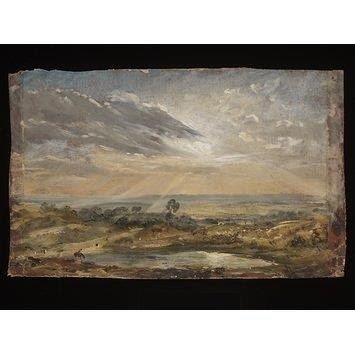 Branch Hill Pond, Hampstead, 1821-22 (above)
Branch Hill Pond, Hampstead, 1821-22 (above)
 Landscape with a Kiln, 1821-22on the reverse
Landscape with a Kiln, 1821-22on the reverse
 Constable The Opening of Waterloo Bridge seenfrom Whitehall Stairs June 18th, 18171832, Tate Britain This is just a taste of the many delights in this outstanding exhibition curated by Dr. Mark Evans, FSA, Senior Curator of Paintings at the Victoria and Albert Museum. Highly recommended!!The exhibition website is here.
Constable The Opening of Waterloo Bridge seenfrom Whitehall Stairs June 18th, 18171832, Tate Britain This is just a taste of the many delights in this outstanding exhibition curated by Dr. Mark Evans, FSA, Senior Curator of Paintings at the Victoria and Albert Museum. Highly recommended!!The exhibition website is here.
 According to the Exhibition curator, "Constable: The Making of Master reveals the hidden stories of how John Constable created some of his most loved and well-known paintings. On display are such famous works as The Haywain together with the oil sketches he painted outdoors direct from nature." The exhibition continues in London until January 11, 2015. If you are near London, don't miss it.
According to the Exhibition curator, "Constable: The Making of Master reveals the hidden stories of how John Constable created some of his most loved and well-known paintings. On display are such famous works as The Haywain together with the oil sketches he painted outdoors direct from nature." The exhibition continues in London until January 11, 2015. If you are near London, don't miss it.
 Constable is one of England's best-loved painters. Born in 1776 in Suffolk, he studied hard to become a painter of note, though he was elected to the Royal Academy only at age 52. The exhibition looks at the paintings he studied, and shows many of his sketches for later works that continue to capture the public imagination two hundred years later.
Constable is one of England's best-loved painters. Born in 1776 in Suffolk, he studied hard to become a painter of note, though he was elected to the Royal Academy only at age 52. The exhibition looks at the paintings he studied, and shows many of his sketches for later works that continue to capture the public imagination two hundred years later.
 John Constable 1776-1837Self Portrait, from the National Portrait Gallery, London
John Constable 1776-1837Self Portrait, from the National Portrait Gallery, London
 Thomas Gainsborough, Landscape with a Pool, c. 1747Fitzwilliam Museum, Cambridge University Among the many influences on Constable was his fellow native of East Anglia, Thomas Gainsborough (1727-1788). Constable is said to have preferred the more natural style of Gainsborough's early landscapes to his celebrated portraiture. Below, Landscape with a Pool in the Constable exhibition.
Thomas Gainsborough, Landscape with a Pool, c. 1747Fitzwilliam Museum, Cambridge University Among the many influences on Constable was his fellow native of East Anglia, Thomas Gainsborough (1727-1788). Constable is said to have preferred the more natural style of Gainsborough's early landscapes to his celebrated portraiture. Below, Landscape with a Pool in the Constable exhibition.
 Claude Lorrain (1604/5-82) -- below -- was another strong influence on Constable in developing his landscape style.
Claude Lorrain (1604/5-82) -- below -- was another strong influence on Constable in developing his landscape style.
 Landscape with Hagar and the Angel, 1646, by Claude LorrainNational Gallery, London
Landscape with Hagar and the Angel, 1646, by Claude LorrainNational Gallery, London
 Constable, Dedham Vale from the Coombs, 1802, V and A CollectionShows the influences of the Claude work above which Constable knew well. Another early work by Constable is below.
Constable, Dedham Vale from the Coombs, 1802, V and A CollectionShows the influences of the Claude work above which Constable knew well. Another early work by Constable is below.
 Moonlight Landscape with Hadleigh Church, 1796Private Collection
Moonlight Landscape with Hadleigh Church, 1796Private Collection
 Constable, Two Studies of Ploughs, 1814V and A Constable was a careful draughtsman as well as an inspired and imaginative painter. He worked hard to reach accuracy in all regards, as in the studies of ploughs (above and clouds (below).
Constable, Two Studies of Ploughs, 1814V and A Constable was a careful draughtsman as well as an inspired and imaginative painter. He worked hard to reach accuracy in all regards, as in the studies of ploughs (above and clouds (below).
 This study of clouds dates from about 1821. Another technique Constable experimented with was painting outside, in the open air. Work had to be fast to catch the light effects before they changed. The work below was done in a friend;s grdin in about an hour.
This study of clouds dates from about 1821. Another technique Constable experimented with was painting outside, in the open air. Work had to be fast to catch the light effects before they changed. The work below was done in a friend;s grdin in about an hour.
 The Close, Salisbury, 1829V and A
The Close, Salisbury, 1829V and A
 Part of the fun of attending a press preview is watching the other writers and photographers at work.
Part of the fun of attending a press preview is watching the other writers and photographers at work.

 From the text panel: "Drawing on Glass...Constable captured scenes from nature by sketching them on paper. His initial pencil drawing could then be inked over and squared up to transfer the composition to a canvas for painting We can see this method in the surviving preparatory sketch and its finished paining Watermeadows at Salisbury."
From the text panel: "Drawing on Glass...Constable captured scenes from nature by sketching them on paper. His initial pencil drawing could then be inked over and squared up to transfer the composition to a canvas for painting We can see this method in the surviving preparatory sketch and its finished paining Watermeadows at Salisbury."
 Sketch: Watermeadows at Salisbury 1829-30
Sketch: Watermeadows at Salisbury 1829-30
 Constable, Watermeadows at Salisbury, 1829-30V and A
Constable, Watermeadows at Salisbury, 1829-30V and A  Two versions of the renowned Constable painting The HayWain 1821
Two versions of the renowned Constable painting The HayWain 1821
 Salisbury Cathedral from the Bishop's Grounds, 1823V and A While preparing the exhibition, conservators at the V and A discovered an oil sketch on the reverse side of Branch Hill Pond, Hampstead. A special mount was designed to show both paintings, showing, " a narrow clearing fringed by trees against an unsettled sky...probably made in the late summer of 1821 or 1822 when Constable painted a number of sketches featuring similar could studies and motifs..."
Salisbury Cathedral from the Bishop's Grounds, 1823V and A While preparing the exhibition, conservators at the V and A discovered an oil sketch on the reverse side of Branch Hill Pond, Hampstead. A special mount was designed to show both paintings, showing, " a narrow clearing fringed by trees against an unsettled sky...probably made in the late summer of 1821 or 1822 when Constable painted a number of sketches featuring similar could studies and motifs..."
 Branch Hill Pond, Hampstead, 1821-22 (above)
Branch Hill Pond, Hampstead, 1821-22 (above)
 Landscape with a Kiln, 1821-22on the reverse
Landscape with a Kiln, 1821-22on the reverse
 Constable The Opening of Waterloo Bridge seenfrom Whitehall Stairs June 18th, 18171832, Tate Britain This is just a taste of the many delights in this outstanding exhibition curated by Dr. Mark Evans, FSA, Senior Curator of Paintings at the Victoria and Albert Museum. Highly recommended!!The exhibition website is here.
Constable The Opening of Waterloo Bridge seenfrom Whitehall Stairs June 18th, 18171832, Tate Britain This is just a taste of the many delights in this outstanding exhibition curated by Dr. Mark Evans, FSA, Senior Curator of Paintings at the Victoria and Albert Museum. Highly recommended!!The exhibition website is here.
Published on November 21, 2014 00:30
Kristine Hughes's Blog
- Kristine Hughes's profile
- 6 followers
Kristine Hughes isn't a Goodreads Author
(yet),
but they
do have a blog,
so here are some recent posts imported from
their feed.































